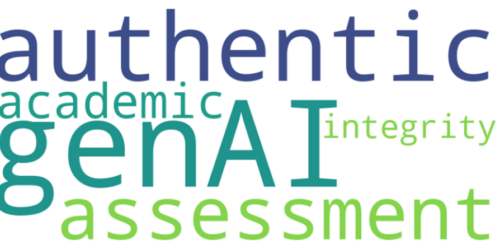
Alternatives to Graded Weekly Pre-Reading Quizzes
Many faculty wish that students would engage more meaningfully with assigned class pre-readings and other materials. When students show up to class not having spent significant time reviewing pre-work (or even opening the materials at all!), it can feel disheartening and you may be unsure how to proceed. Should you adapt your lesson plan in the moment and go over some of the key points that students missed from the pre-work so they can better follow along when you share new content in class? Should you charge on full speed ahead, going through the 48 slides you need to cover in the next 2 hours, hoping that students get the message that if they don’t do this preparatory work, they’ll fall behind and may be inspired to adapt their behaviour next week?
In some cases, in an effort to incentivize students to complete class pre-readings, (and to encourage consistent attendance and participation) faculty members have started implementing graded pre-reading quizzes near the start of each class.
This hub post outlines some of the benefits and risks associated with this practice and offers alternative suggestions that can help you achieve similar aims in ways that are more supportive of student well-being, engagement, and learning retention
Pre-reading quizzes
In an ideal world, students would always show up to class with a strong intention to learn—having completed the required readings and reviewed other asynchronous materials diligently because they are deeply passionate about the subject at hand and eager to toss ideas around in class with their peers–not because they know they’ll be tested on the material.
In the world as it is, students have many competing priorities that sometimes make it difficult for them to engage as fully as they would like to with weekly pre-reading materials. Students may also see this task as “optional” if they know it’s not being directly assessed. This can be frustrating for many faculty members who show up each week with a strong intention to teach and a lot of material to cover.
In response to this frustration, some faculty have decided to build in regular graded quizzes to test whether or not students have engaged with (and retained specific details from) weekly pre-readings. These quizzes typically consist of 5-15 multiple choice questions as these can be more easily graded automatically by a learning management system and so are less taxing on instructors themselves. Sometimes these quizzes take on other formats as well.
Potential benefits of evaluated pre-reading quizzes
Research suggests that there are certain benefits associated with regular pre-reading/ retrieval quizzes, if done in a supportive manner.
For example, there is convincing evidence (Heiner-Banet-Wieman, 2014; Pape-Lindstorm et al., 2018) that regular reading quizzes can improve exam scores for community college students as this imposed course structure helps students self-regulate their learning and arrive to class better prepared to participate—especially students who are underrepresented in their disciplines and/or come from low socio-economic backgrounds. Clement (2016) also found that more deliberate course structure, that included regular graded assessments like pre-reading quizzes to test students’ knowledge, effectively impacted students’ time management and improved their study habits more generally. Richards-Babb (2018) found that the use of an adaptive online homework system that tested students’ knowledge after reading textbook chapters also had a positive impact on grades for those who were scoring average or below average in the course.
Tropman (2014) found that students in various disciplines actually appreciate regular pre-reading quizzes and the positive impact they can have on the classroom community and students’ accountability to each other’s learning. These assessments are particularly effective when structured around key ideas from the readings (instead of inconsequential details) and when the “why” of the task is made clear. For example, rather than an instructor saying: “please read these 20 pages before class next week, you’ll be quizzed on the content,” they could say instead: “review these 20 pages, but focus especially on these 3 topics _____, _____, ______ because these are vital to our understanding of the main themes we’ll be building on in class next week.”
Other research (El-Hashah, 2022; Sotola, 2020) has found that when weekly pre-reading quizzes are accompanied by formative feedback from professors, both the teacher-student relationship and course satisfaction rates were enhanced, and midterm and final exam scores improved.
Potential consequences associated with evaluated pre-reading quizzes
As a counterpoint to the benefits of this practice, there are also a number of downsides that should be considered.
One critique is that while weekly graded multiple-choice quizzes might provide extrinsic motivation for students to do the readings, they don’t actually inspire their intrinsic desire to learn and connect with course materials in ways that are meaningful and relevant to them. This type of extrinsic motivation has been linked to socially prescribed perfectionism and increased rates of anxiety, depression and obsessive compulsive behaviour (Stoeber et al., 2009).
Additionally, while there are many reasons college students might experience stress, a growing body of evidence suggests that academic stress is paramount amongst them. Barbayannis et al (2022) note that more than 87% of college students surveyed across the United States cite academic stress (including course load, and studying and time management struggles) as their “primary source of stress” (p. 2). Reflecting on the student situation at Conestoga, where many students are studying full-time (often with 5 or more courses each semester) and working for income outside of their studies, we can imagine how stressful it might feel if one was asked to complete all of the required readings for every course each week, knowing they’d be tested on the material in each class. This would be on top of keeping track of and completing higher-stakes assessments for each course.
As noted, multiple-choice questions are the most common format for pre-reading quizzes. The literature suggests that while these types of tests are relatively easy for faculty members to create, administer, and grade, they do a poor job of actually measuring students’ understanding of the material, and their ability to apply underlying concepts (Evanick, 2023). There are also some problematic performance gaps when looking at MCQ test results administered to Native English speakers as compared to students for whom English is an additional language.
Alternative suggestions
Presented with this research, there are ways to work towards achieving the benefits associated with regular pre-reading quizzes, while also helping ensure students engage meaningfully with the material in ways that won’t cause undue stress. Below are some options to consider:
(1) Ungraded weekly quizzes on key aspects of the readings. While graded weekly pre-reading quizzes are not always advisable for the reasons mentioned above, ungraded pre-assessments that check on students’ pre-existing knowledge, skills, and/or attitudes about certain topics before diving into the main lesson are a vital component of a BOPPPS lesson planning framework and are part of an overall effective teaching strategy. Many faculty members incorporate these quizzes into the start of their classes–often using MentiMeter or Zoom polls, where participants remain anonymous (this helps students answer honestly, and helps protect faculty members from forming unconscious biases). In these cases, faculty can still craft questions (multiple choice or otherwise) that assess student learning, and help them better understand the key themes, ideas, or definitions they should have extracted from the readings. In these cases, students will be able to assess their own score compared to their classmates, and faculty members can provide formative feedback in the moment and adapt the coming lesson to fill in gaps in knowledge or address misunderstandings.
(2) Jigsaw-style sharing of the workload: If there is a significant amount of pre-reading to do for your course, and you sense students are overwhelmed and unlikely to complete it, perhaps instead of asking each student to do the entire reading, you could break the class into groups and have each group be responsible for a few pages. You might create a shared document with prompts to help guide students as they read (e.g. key terms to look out for and define etc.)–stressing that each group is responsible for taking notes on the shared document for the whole class to review and use as a resource for upcoming exams. This jigsaw approach also helps encourage peer-to-peer learning.
(3) Consider frequency and weight: If graded pre-assessments will be a part of the course you’re teaching, consider how much each quiz will be worth and how often they’ll take place. Research shows that in-class evaluations worth less than 5% rarely motivate students to come to class or engage with the material. For example, perhaps having 3 quizzes scattered throughout the semester worth 5% each instead of weekly quizzes worth just 1-2 %, might result in less stress for students, while still assisting them to stay on track with their readings and note-taking.
(4) Alignment: If these low/no stakes quizzes/ evaluations mirror the content and format of forthcoming higher-stakes summative evaluations, students are also more likely to feel supported and “buy in”. (i.e. if the mid-term and final exams will consist of multiple-choice questions, it would be a good idea for weekly quizzes to reflect similar questions and phrasing). If this alignment is made explicit for students, they will be more willing to invest time and energy in studying for these quizzes and attending class to review formative feedback that will set them up for success of the higher stakes evaluations. Research also indicates that the closer these “retrieval” style tests take place to the larger summative exams, the more likely students are to succeed on the higher-stakes evaluations (Berwick, 2019).
(4) Set aside class time to review key aspects of pre-work: Whether a graded or ungraded activity, consider setting aside some class time each week (15-20 mins) for students to review key components of the pre-readings that you’ve curated for them. For example, if students were asked to read a 15 page chapter before class, when they arrive ask them to focus on the 3-4 pages that you think are most relevant to the content that will be shared in class. Then provide them with a prompt (such as: “as you read pages 5-8, consider which issue being shared is most important in a Canadian health care context today and why.” Or “on page 6, the author says _____________, what exactly does she mean by this? Do you agree? Review pages 5-8 for context for the next 10 mins and then be ready to share your ideas with the class.” In some courses, this sort of supportive pre-reading review might take place each week and be graded (1% each week, students submit their responses during class time to the proper dropbox folder). When this is the case, typically students will be able to drop their lowest grades at the end of the semester. (e.g. if there are 12 of these in-class low-stakes graded assessments throughout the semester, each one worth 1 %, and totaling 10% of a student’s overall grade in the course, even if a student is away for 2 weeks and misses 2 opportunities, they can still achieve the full 10% if they do only 10 of these activities, dropping their 2 lowest grades for the weeks they missed).
References
Berwick, C. (2019) October 25. What does the research say about testing? Edutopia. Retrieved from: https://www.edutopia.org/article/what-does-research-say-about-testing
Clement L. (2016). External and internal barriers to studying can affect student success and retention in a diverse classroom. Journal of Microbiology and Biology Education, (3), 351–359. 10.1128/jmbe.v17i3.1077
Dobson, J.L. (2008). The use of formative online quizzes to enhance class preparation and scores on summative exams, Advanced Physiological Education. 32(4), 297–302.
El-Hashash, A. (2022). Weekly Quizzes Reinforce Student Learning Outcomes and Performance in Biomedical Sciences in-course Assessments. Open Journal of Educational Research, 2(4), 168–178. Retrieved from https://www.scipublications.com/journal/index.php/ojer/article/view/273
Evanivk, J. (2023). March 24. The Problems with Multiple Choice Exams and More Effective Alternatives. ELearning Industry. https://elearningindustry.com/problems-with-multiple-choice-exams-and-more-effective-alternatives
Heiner, C., Banet, A., Wieman, C., Amer. J. (2014) Preparing students for class: How to get 80% of students reading the textbook before class. Physics 82(10), 989 doi: 10.1119/1.4895008
Kolpikova, E. P., Chen, D. C., & Doherty, J. H. (2019). Does the Format of pre-class Reading Quizzes Matter? An Evaluation of Traditional and Gamified, Adaptive Pre-class Reading Quizzes. CBE Life Sciences Education, 18(4), ar52. https://doi.org/10.1187/cbe.19-05-0098
Sotola, L., Crede, M., (2020). Regarding Class Quizzes: A Meta-analytic Synthesis of Studies on the Relationship Between Frequent Low-Stakes Testing and Class Performance. Educational Psychology Review. DOI: 10.1007/s10648-020-09563-9
Pape-Lindstrom, P., Eddy, S., Freeman, S., Schinske, Jeff (2018). Reading quizzes improve exam scores for community college students. CBE—Life Sciences Education, 17(2), ar21. doi: 10.1187/cbe.17-08-0160
Richards-Babb, M., Curtis, R., Ratcliff, B., Roy, A and Taylor Mikalik. General Chemistry Student Attitudes and Success with Use of Online Homework: Traditional-Responsive versus Adaptive-Responsive. Journal of Chemical Education 2018 95 (5), 691-699. DOI: 10.1021/acs.jchemed.7b00829
Stoeber J., Feast, A. R., Hayward J.A. (2009). Self-oriented and socially prescribed perfectionism: differential relationships with intrinsic and extrinsic motivation and test anxiety. Personality and Individual Differences. 47(5), 423–428.
Tropman, E., (2014). In defense of reading quizzes. International Journal of Teaching and Learning in Higher Education, 26 (1), 140-146.






